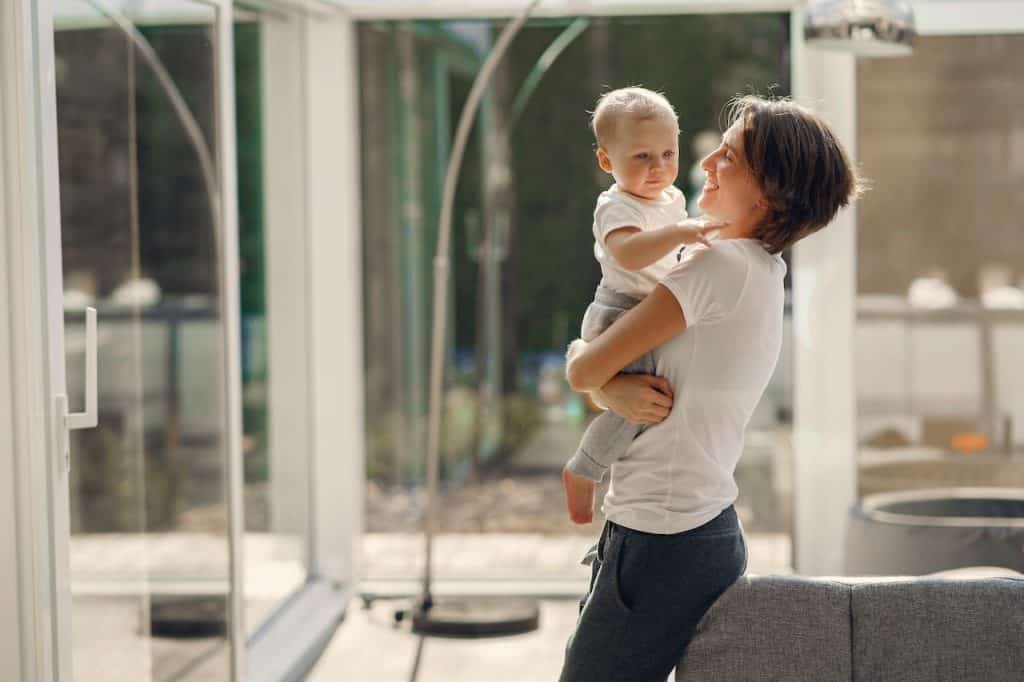Keeping your baby upright after they eat is a fairly standard procedure. It aids digestion by giving gravity some time to help their stomach contents move down through their digestive tract and by allowing trapped air bubbles to rise up and out of their system. It also gives you time to burp them, which reduces spitting up.
Try to keep your baby upright for at least 15 to 30 minutes after each feeding. There are some situations where you may need to keep them upright for longer (up to an hour in some cases), such as if your baby has GERD, spits up a lot, or swallows a lot of extra air while feeding.
Keeping a baby upright is just another one of the many steps caregivers have to take note of in the process of feeding a baby. This article serves as a short guide to why and for how long babies need to be kept upright after feeding as well as some things to watch out for while keeping a baby upright after feeding.
Why Do Babies Need to Be Held Upright After Feeding?

In adults and older children, a muscle in between the stomach and the esophagus known as the lower esophageal sphincter acts as a barrier to keep stomach contents from rising back up through the esophagus. It opens up to allow food and liquids to enter your stomach when you swallow and to allow trapped air and other gastric contents out when you belch.
In babies less than 2 years old, this muscle does not yet have enough strength and tone to function properly at all times. As a result, the muscle may open up at random times, causing reflux. This type of reflux and spitting up is normal in babies and usually improves by their first birthday.
Spit up is normally white or cream in color if your baby spits up right after a feeding. It may also appear slightly yellowish and curdled if the milk has sat in their stomach for some time and has already been partially digested.
While your baby is upright, gravity works in favor of their digestion. It assists in the movement of milk down through their stomach and into the small intestine, making their stomach less full, and decreasing the amount of spit up they produce once you do put them down for a nap or a diaper change.
At the same time, the upright position gives any air they may have swallowed during the feed time to rise above the rest of their stomach’s contents, making it easier for gas to escape when you burp them.
How Long Do I Need to Keep My Baby Upright After Feeding?

Most spitting up occurs right after your baby has eaten, when their stomach is fullest. Putting your baby down too soon after feeding can worsen gastric reflux and increase spitting up.
When holding your baby upright, try to keep their body straight as much as possible. Avoid using an upright sitting position as this may put additional pressure on their stomach and worsen reflux. Tight clothing around the waist like snug-fitting pants and too-tight diapers may also have the same effect.
Staying upright for 10-15 minutes after feeding may be enough time to allow your baby’s stomach contents to settle. This should also give you enough time to burp them, either over your shoulder or sitting upright on your lap.
You can also use this time to do some skin-to-skin contact, which can help both you and your baby relax and sleep better as well as potentially reduce reflux and spitting up.
If your baby still spits up quite a bit even after being upright for 15 minutes, try keeping them upright for up to 30 minutes after they feed. Babies who have gastrointestinal conditions such as GERD or esophagitis may need to be held upright for up to an hour.
Can I Use a Bouncer to Keep My Baby Upright?
Understandably, holding and rocking a 10–15-pound baby for that long can be exhausting, especially after a night feed when all you want is to get back into bed and sleep. Muscle fatigue and strain are quite common after holding a baby for an extended time.
A bouncer or baby swing with an upright or inclined seat can give your arms a break while also keeping your baby upright, as long as you continue to supervise them in the seat. A baby-wearing harness or carrier might also be of use to keep your baby upright.
Note that your baby should not be left to sleep in an upright position unless you are otherwise advised by their pediatrician. If they do happen to fall asleep in a sitting device, make sure to move them to a safe sleeping surface as soon as possible. Do not use pillows, crib wedges, or any other sleep positioner to prop your baby up in their crib.
At What Age Can I Stop Holding Baby Upright After Feeding?
Unfortunately, there is no one size fits all answer to this question. But the good news is that your baby will eventually outgrow spitting up as their digestive muscles mature. Most babies will outgrow spitting up by 12 months of age.
Like with a lot of other aspects of parenthood, it may take some trial and error to figure out what works best for your baby. Babies who do not spit up very much might not need to be held any longer than it takes to burp them. Babies who spit up more or have issues with reflux may need to stay upright for longer after a feed.
Babies usually gain better control of their lower esophageal sphincter around 4-6 months of age, which is usually when you can stop burping them too. If you notice that your baby has begun to spit up less or has even stopped spitting up entirely, you may try decreasing the amount of time you spend keeping them upright after a feed.
What If My Baby Still Spits Up After Keeping Them Upright?
The recommendation to keep a baby upright after feeding them is mainly to reduce reflux and spitting up. For most babies, spitting up 1-2 tablespoons after each feeding is a normal part of infancy and is nearly impossible to eliminate completely, even with keeping upright and frequent burping.
Spitting up only becomes a problem if you notice any of the following signs with your baby:
- Difficulty gaining weight
- Vomiting or spitting up forcefully
- Constipation
- Dehydration or having fewer wet diapers than usual
- Loss of appetite
- Spitting up blood or coffee-ground like substance
- Choking or other signs of trouble breathing
Take your baby to see their healthcare provider if you see any of these signs. Treatments may range from short-term use of an acid-blocking medication such as a proton pump inhibitor, to using a feed thickener to increase the viscosity of the breastmilk or formula, or even just feeding smaller and more frequent meals.